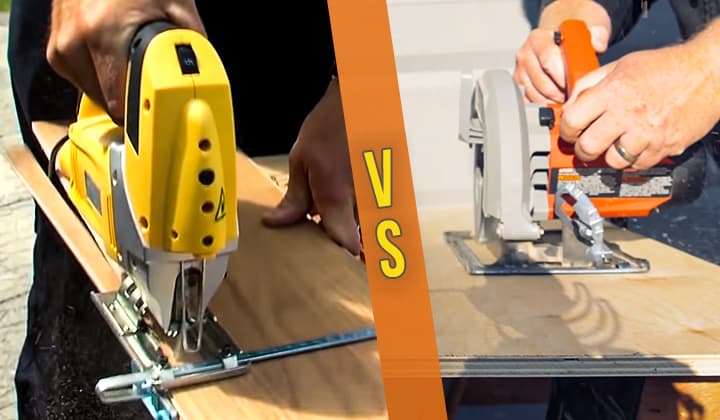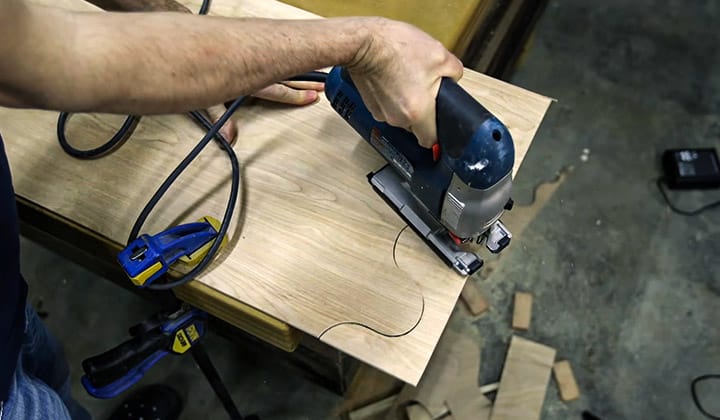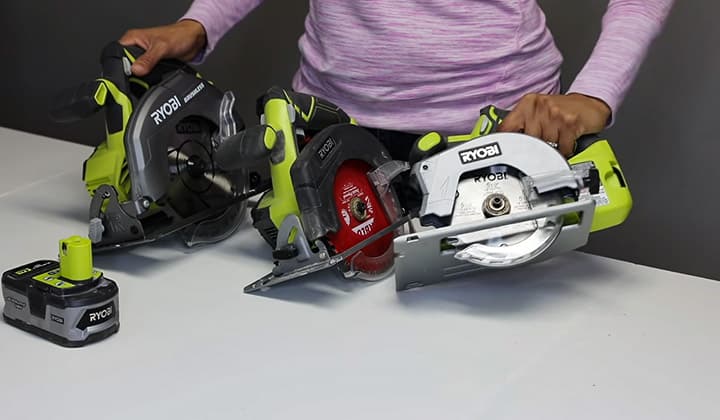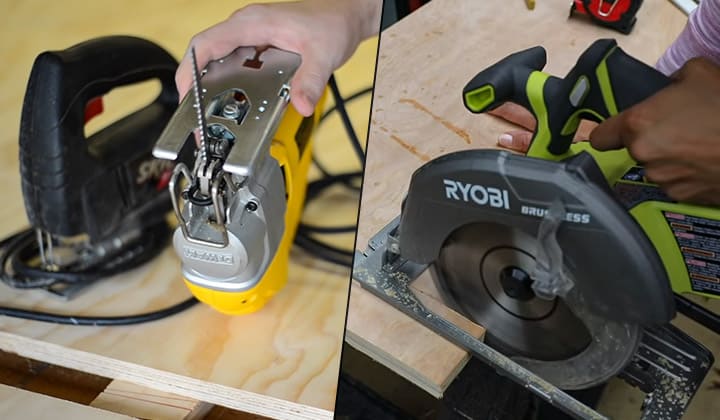If you are wondering whether to stick to the circular saw or to get a jigsaw? Don’t worry; you are not alone. In fact, it is a frequently raised question in the woodworking community.
I’m not here to end the discussion once and for all. I am no Thanos. But I am going to shed some light on the matter in this discussion about jigsaw vs. circular saw. And hopefully, end your confusion.
Hopefully, we both know what a jigsaw and a circular saw are. They are both power tools like all of these types and used to cut different types of materials, mostly wood but a metal sheet, plastic, as well as ceramic works as well. 
However, the two tools use two different mechanisms to make the cut. In this article, we will go through their advantages and disadvantages and see which one fits your needs better.
In this post we'll cover:
What Is A Jigsaw?
A jigsaw is a power tool that uses a thin short blade to cut across a workpiece precisely. One end of the blade is connected to the motor inside the housing via gears, and the other end is free.
When operating, the motor creates an up-down motion on the blade, which in term makes small chips of the wood and helps to cut it. Mostly a jigsaw runs by electricity directly, but wireless, battery-powered jigsaw models are also available.
On average, a jigsaw makes 2000 – 2500 RPM. It is not the fastest power tool, but it is indeed enough to make dust-like chips of the workpiece and yield a neat result. Adding sanding is required, but that mostly depends on the blade you are using.
The main advantage that a jigsaw provides is that it allows you to make turns easily. Both a sharp turn as well as a wide turn is a piece of cake when working with a jigsaw. Hence a jigsaw is mostly used to create pretty complex yet fantastic shapes.

What Is A Circular Saw?
A circular saw is also a power tool, but unlike a jigsaw, a circular saw uses bigger and circular blades; hence the name, “circular saw”. The big and bulkier blade is attached to the motor at the center and spins directly powered by the motor.
No fancy gear system is required. Like a jigsaw, that power source of a circular saw is electricity. However, the odd ones use a battery to operate.
Depending on brand and model, a jigsaw is easily capable of producing 5000+ RPM, thanks to the absence of the fancy gear system. Both the blade size and type is amazingly diverse, which, in turn, determines the quality and efficiency of cuts.
Because of the shape of the blade, a circular saw is unable to make sharp turns. Hell, It is quite the task to make any turn at all. But that is not what a circular saw is used for. They are mainly used for making long cuts (both with the grain and against) fast.
Make no mistake. With proper experience and skill, a circular saw can be used to do incredible tasks and make decently complex designs that can sometimes even surpass the jigsaw. But that comes at the cost of “experience” and time.

Comparison Between Jigsaw And Circular Saw
As I mentioned above, both of the tools are very versatile. With proper blade and experience, you can easily get the same result from either of the two. What makes the difference is speed and efficiency.

Cutting Performance
A circular saw is much faster at making long and straight cuts due to the higher RPM. At the same time, there is less room for mistakes and slipping, thanks to the longer blade.
Whereas for a jigsaw, it is relatively harder to achieve since the only thing keeping you on the line is the “line” you drew on the piece. And due to the thinner blade, you can get off the track much more easily.
Curved Cuts
However, A jigsaw shines at making curved cuts. Its thin blade allows it to take a turn with hardly any consequences. This allows you to make very neat and pretty precise curves, both inside and outside curves. Making curves with a circular saw, on the other hand, is a pain.
Speed & Accuracy
It is by no means impossible. With the proper blade, it is very much possible. But in terms of speed and accuracy, a jigsaw beats a circular saw by a great deal.
Groove Cuts
If you want to make dadoes or grooves, it’s a different story. Neither of the tools is great at grooving. But it is possible to use either one. But it is much easier to manipulate a circular saw.
Material Compatibility
It is a similar story when working with ceramics and tiles. A circular saw is much safer to use when working with sensitive materials. It is easier to shatter the workpiece when working with a jigsaw.
Blade Options
In terms of blade options, a circular saw has a wide variety to choose from. Blades like ripping blade, plywood blade, finishing blade, grooving blade, masonry blade, or metal blade, you name it. Specialized blades for a circular saw are relatively easy to find compared to the counterpart for a jigsaw.
Skill Cap
The skill-cap for a circular saw is relatively higher than that of a jigsaw. Now, I’ll admit that it is comparatively harder to learn and master the tool as well, But the potential is also quite a bit higher.
A jigsaw, on the other hand, is a tad bit friendlier for newcomers. Operating a jigsaw when starting out in this line is easier. It is easy to learn, and you won’t make mistakes as easily.
All in all, a circular saw is much more versatile than a jigsaw. Of course, even the circular saw has its drawbacks. But the point is, limitations are minimal, and it is quite easy to manipulate a circular saw. The skill-cap of a circular saw is relatively higher, therefore more potential to push your skills a bit more.
Summary
Now, the question we started with, which one to stick to? To get the answer to this, consider your situation. Which type of cuts will you be making? Are you into detailed and intricate designs? Will you be doing it for just fun or professionally? Is time the main factor for you, or is it perfection?
In between the two, a circular saw will help you at making fast cuts, straight rips. Thus, it will be the most useful at the professional level, especially for making furniture or frames.
On the other hand, if you are in it more as a hobbyist, and you can afford the time it takes, and would rather go for the perfect finish, a jigsaw is the answer for you. There will be a lot of times when you will be thanking yourself for getting a jigsaw.
Conclusion
In general, it is best to have both the tools, if available and affordable. Because the tools work best in different sectors, therefore, they complement each other, more so than compete. Using a circular saw for ripping, dadoing, and making the framework ready, while using the jigsaw for the designs will get you the best results.
I'm Joost Nusselder, the founder of Tools Doctor, content marketer, and dad. I love trying out new equipment, and together with my team I've been creating in-depth blog articles since 2016 to help loyal readers with tools & crafting tips.
